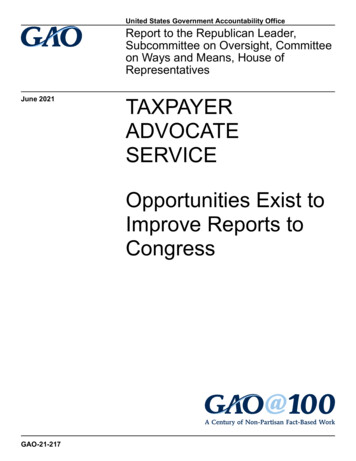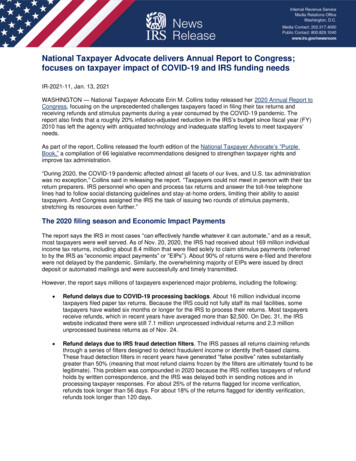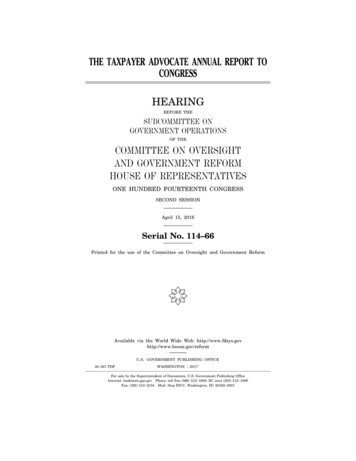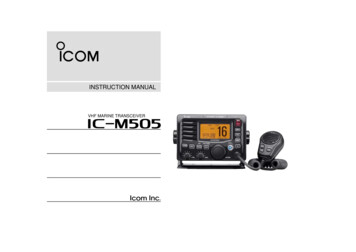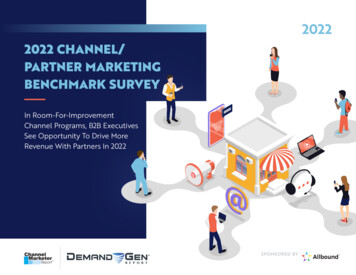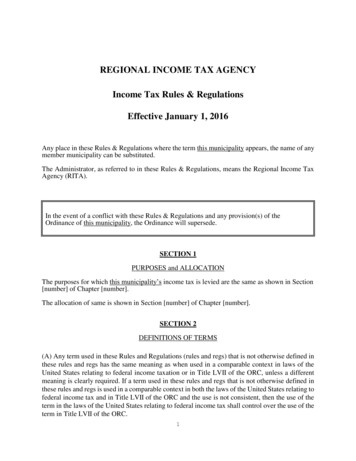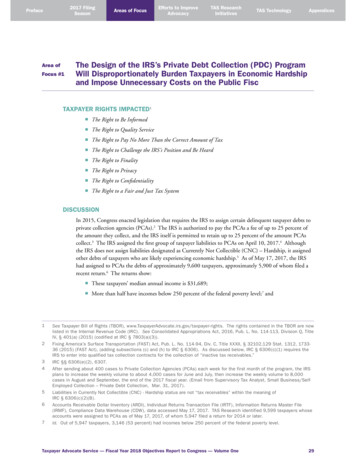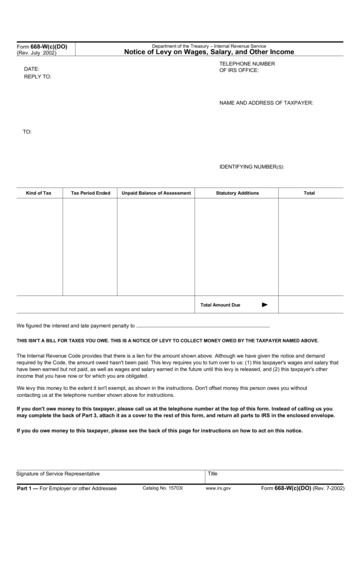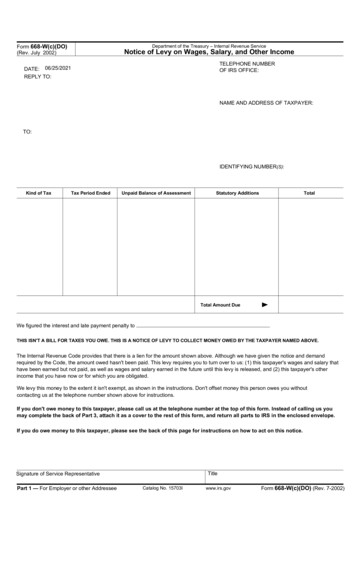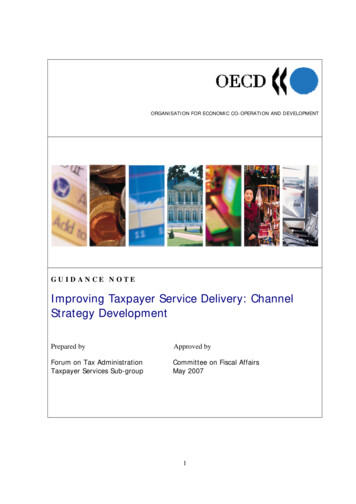
Transcription
ORGANISATION FOR ECONOMIC CO-OPERATION AND DEVELOPMENTGUIDANCE NOTEImproving Taxpayer Service Delivery: ChannelStrategy DevelopmentPrepared byApproved byForum on Tax AdministrationTaxpayer Services Sub-groupCommittee on Fiscal AffairsMay 20071
TABLE OF CONTENTSABOUT THIS DOCUMENT . 4Purpose . 4Background . 4Caveat . 4Inquiries and further information . 5SUMMARY . 6INTRODUCTION . 71 GUIDING PRINCIPLES . 91) Develop a channel strategy to improve service delivery and compliance . 92) Move towards a holistic channel approach . 93) Put the customer in the centre. 94) Raise channel cost awareness. 105) Establish sound implementation and evaluation systems for the channel strategies . 102 CHANNEL STRATEGY DEVELOPMENT . 11What is a channel strategy? . 11Stakeholders are shaping channel strategy development. 12Government as stakeholder. 13The revenue body as stakeholder . 14The user as stakeholder . 14The tax agent as stakeholder.15Other stakeholders .15Revenue bodies’ channel strategies.15How the strategies are developed .15An optimal channel mix . 16Approaches to common strategic topics .17Channel strategy as a tool for increasing compliance .17Channel strategies as a tool for promoting cost efficiency and user friendliness . 18Increased cooperation with other government bodies . 18Customer relationship management (CRM) . 193 A HOLISTIC CHANNEL APPROACH.21Which services do the different revenue bodies offer? . 21Which channels are being used? . 23Convergence of different channels . 24The main developments of the different channels. 27Electronic channels . 27A multi channel future . 354 THE CUSTOMER IN THE CENTRE . 37Customer segmentation . 37User value . 41User value as a main driver in revenue bodies' channel strategies. 39User value analysis . 425 INCREASED AWARENESS OF COSTS . 45Channel costs . 45Reducing unnecessary contact . 47Channel Migration .48Cost analysis.482
6 IMPLEMENTATION AND EVALUATION OF CHANNEL STRATEGIES .51Introduction.51The use of incentives. 52The use of communication and mass communication. 53Organisational considerations. 54Measuring successful implementation of the strategy . 56CONCLUSION. 57A consistent approach when changing channel use patterns . 57Key advice. 57APPENDICES . 58Appendix 1 – Channel strategy development in different countries . 58Australia . 58Canada. 59Ireland. 59Norway .60Sweden . 62United Kingdom . 62United States. 65Appendix 2 – Interview guide and process/method. 68Interview guide .68Process/method . 70FIGURESFigure 2.1 Elements influencing channel strategy . 12Figure 2.2 Australian Taxation Office - Hierarchy of channel preferences.17Figure 3.1 Hierarch of service channels. 22Figure 3.2 Online Service Delivery Maturity .28Figure 3.3 Multiple-channel service delivery . 35Figure 3.4 Multi-channel service delivery. 36Figure A1. The ATO’s hierarchy of channel preferences. 59Figure A2. The Swedish channel strategy .63Figure A3 TAB Phase 1 and 2, timeline and outcomes.66TABLESTable 3.1 Service categories and examples . 21Table 3.2 Strengths and weaknesses of the different channels for service delivery . . . 23Table 5.1 Norway. Cost analysis examples . .483
ABOUT THIS DOCUMENTPurposeThe purpose of this guidance note is to promote thinking among revenue bodies on thedevelopment of a channel strategy, a set of actions intended to achieve optimal usage of thevarious means (i.e. channels) for delivering services to taxpayers. The note provides ideas ondeveloping such a strategy, based largely on the experiences of selected revenue bodies.BackgroundRecent years have witnessed major reforms in public sector administration as governmentsstrive to improve the efficiency and effectiveness of their operations. Central to thesereforms has been the establishment of sound governance practices, including the applicationof modern technology in delivering information and transaction services to taxpayers.During meetings of the CFA’s Forum on Strategic Management (now the Forum on TaxAdministration) in 2002 it was agreed that further work should be carried out by country taxofficials to share experiences and to provide more comprehensive guidance on the provisionof electronic services to taxpayers. The Forum’s Taxpayer Services Sub-group wasestablished with this objective in mind. The Sub-group’s mandate is to 1) periodicallymonitor and report on trends in taxpayer service delivery, with a particular focus on thedevelopment and deployment of electronic services (hereafter referred to as ‘e-services’) byrevenue authorities; 2) examine ways to promote the uptake and use of e-services by revenueauthorise; 3) examine options for cross-border administrative simplification andconsistency; and 4) assist, as appropriate, other groups of the Committee of Fiscal Affairs(CFA) in their work on taxation.The Norwegian Tax Directorate co-ordinated this work with the aid of invaluablecontributions from Australia, Canada, Ireland, the Netherlands, Sweden, United Kingdom,and the United States and prepared a first draft of this note. Other members of the Forum onTax Administration’s Taxpayer Services Sub-group also provided useful input in thedeliberations leading up to its completion.CaveatEach revenue authority faces a varied environment within which they administer theirtaxation system. Jurisdictions differ in respect of their policy and legislative environmentand their administrative practices and culture. As such, a standard approach to taxadministration may be neither practical nor desirable in a particular instance. Thedocuments forming the OECD tax guidance series need to be interpreted with this in mind.Care should always be taken when considering a country’s practices to fully appreciate thecomplex factors that have shaped a particular approach.4
Inquiries and further informationInquiries concerning any matters raised in this guidance note should be directed to head ofCTPA Tax Administration and Consumption Taxes Division, Richard Highfield, telephone 33 (0)1 4524 9463 or email richard.highfield@oecd.org.5
SUMMARYThe taxpayer service delivery function plays a crucial role in the administration of the taxlegislation in all countries. Providing services that are user-friendly, in the sense of beingaccessible and understandable for all, helps to maintain and strengthen the taxpayers’willingness to comply voluntarily and thereby contribute to improvements in overall levels ofcompliance with the laws.For some time now, revenue bodies have been providing more accessible informationservices through use of new technology (e.g. by building on-line capability or makinginformation available 24 hours a day, 7 days a week). More recently, many revenue bodieshave given taxpayers the functionality of registering for tax system purposes, filing taxreturns and paying tax electronically, all at times convenient to them. There have also beendevelopments in the use of telephony services with revenue bodies in many countriesestablishing large call centre arrangements employing sophisticated telephony technology tofacilitate access by phone for taxpayers to the information and other services they require.The increase in channel options has also made it possible for revenue bodies to choose amore optimal mix of channels, trying to strike a balance between the objectives of improvingcustomer service and the need for revenue bodies to cut costs; these objectives are notmutually exclusive. Developing a sound and comprehensive channel strategy is in thisrespect a win-win exercise, since it makes it necessary to put all crucial channel factorstogether in a consistent and comprehensive way, thereby creating new insights into theexisting channel structure and generating visions of a possible future structure. Well definedstrategic channel objectives are, of course, also a prerequisite for clear directions on how tochange the existing channel structure to the new, preferred one.This guidance note focuses on channel strategy development and implementation from aholistic channel perspective, emphasizing the importance of being customer-oriented, butalso cost conscious when developing channel objectives. In short: What are the major factors to consider when developing and implementing achannel strategy? How to solve the issue of coordinating and integrating multiple channels in anefficient and effective way? What tools are available for creating a positive customer experience acrosschannels? What are the costs connected to the different channels for revenue bodies andtaxpayers and how should they be analysed?The note does not purport to cover all aspects of relevance to the development of a channelstrategy, or to be a comprehensive guide on how channel activities should be conducted.Rather, it draws together information provided by selected member countries throughvarious information-gathering activities conducted over the last two years and presents anarray of facts and observations that may assist member countries improve the efficiency andeffectiveness of their channel activities. Revenue bodies are encouraged to use the ideas andexperiences expressed herein as they take steps to improve service delivery performance.6
INTRODUCTION1.An effective and efficient program of taxpayer service activities is a criticalobjective of all revenue bodies. The general complexity of tax laws coupled withthe relatively large populations of taxpayers to be administered mean that allrevenue bodies must rely substantially on taxpayers’ voluntary compliance toachieve the outcomes expected of them. It is axiomatic that to achieve high levelsof voluntary compliance, taxpayers and their representatives must have a goodstandard of services to help them determine their obligations under the laws andto complete the steps required to acquit those obligations.2.Revenue bodies have a variety of methods (hereafter referred to as “channels”) attheir disposal for delivering services to individual taxpayers and theirrepresentatives. These include the operation of physical sites (e.g. office inquirycentres) enabling face-to-face contacts, the provision of phone inquiry services(including through use of modern call centre facilities), communication by writtencorrespondence using normal postal services, and increasingly through theprovision of electronic services through the Internet and other mechanisms.However, each of these channels is subject to varying strengths andweaknesses, not to mention cost considerations. For example, large officenetworks within a revenue body providing physical face-to-face contact may meetthe needs of some taxpayers who desire the “reassuring” nature of personalcontact services but are likely to entail significant overhead costs (and can typicallyonly be provided in normal business hours). On the other hand, servicesprovided via the Internet can generally be provided universally on a 24 hour/7days a week basis. However, not all taxpayers have access to Internet services andsome segments of a revenue body’s clients may be reluctant to use them.3.Given these sorts of considerations, revenue bodies ideally require a systematicapproach or strategy for arriving at an optimal mix of channels for servicedelivery, one that achieves high standards of effectiveness while at the sametime also meets efficiency objectives, both from the viewpoint of the revenue bodyand taxpayers at large. The term “channel strategy” has been coined withinmodern business literature to describe such an approach.4.A channel strategy affects most organisational dimensions including the technicaland physical infrastructure, all delivery channels, services content, administrativeprocesses and culture. In addition to internal stakeholders, there are also externalstakeholders who often have a view on what the channel strategies should be –individual customers, businesses, government, tax agents and different usergroups. How does a revenue body deal with all these at times conflicting ordiffering interests?5.Given members’ common interests and goals, the Forum on Tax Administrationsaw merit in examining the approaches and experiences of selected revenue bodiesin this area to identify learnings that could be shared more widely and togenerally provide guidance that may be of value to countries wishing to improvethe effectiveness and efficiency of their service delivery activities. This note hasbeen prepared with this objective in mind.7
6.From the work done in preparing this note it is apparent that there is no universalformula for developing a channel strategy. Different revenue bodies and variousother government and non-government organisations have approached this task ina variety of ways. However, there does appear to be a strong body of support for theview that a channel strategy is an important element of a revenue body’s overallstrategy for improved performance.Structure of the guidance note7.8.This note is structured around a set of guiding principles that are based on theexperiences of the eight revenue bodies that participated directly in this work. Part1 provides a brief description of each principle, while subsequent Parts providefurther elaboration, as follows: Part 2 (dealing with guiding principle 1) describes channel strategyobjectives, the different stakeholders of a channel strategy, how channelstrategies are developed and some common approaches to strategictopics. Part 3 (dealing with guiding principle 2) outlines the nature of thedifferent channels as service providers and also describe the challengesand advantages connected to putting a seamless, multi- channelintegration system in place. Part 4 (dealing with guiding principle 3) explains and gives emphasis tothe importance of customer segmentation and elaborates the concept of“user value” as well as giving advice on how to conduct user analysis. Part 5 (dealing with guiding principle 4) analyses in some depth theconcept of channel cost and presents principles for cost analysis as abasis for applying the principle. Part 6 (dealing with guiding principle 5) describes the challenging phaseof channel execution and evaluation.As noted at the outset the guidance note is based on different sources ofinformation such as written material, discussions during workshops, interviewswith channel strategists and more informal discussions with colleagues in differentrevenue bodies.8
1GUIDING PRINCIPLES9.In a rapidly changing environment, one cannot expect concrete step-by-stepguidance and advice since this would be applicable only for a short period in arapidly developing customer contact environment; a detailed and specific guidancenote that might stand the test of time is probably not therefore achievable. Undersuch dynamic circumstances a more generic approach, outlining guiding principlesis considered more appropriate.10.Consequently, this paper does not provide a list of procedures giving directions inspecific situations but, rather, a set of guiding principles that have proven to bevalid in the experience of member countries, and therefore of a more strategicnature. Even within that context, these general guiding principles should berevisited from time to time to verify whether they are still valid or must be replacedby new ones. The following guiding principles have been distilled from insights andinformation gathered from selected revenue bodies and other sources.1) Develop a channel strategy to improve service delivery andcompliance Develop a clear understanding of what you want to achieve with yourchannel strategy i.e. the outcome you want to achieve for theorganisation and its customers Consider channel strategy development in the context of broaderorganisational strategies and objectives Set clear goals for channel strategy development and ideally also someclear targets2) Move towards a holistic channel approach Understand the nature of your services and channels Move towards an integrated channel approach, including governance Define clearly the roles and responsibilities of each channel by customergroup and product Join-up and share services across public bodies where that is sensible3) Put the customer in the centre Understand your customers Use customer segmentation models to add value and support migrationto alternative channels that better meet customer needs Conduct customer surveys and analyses in proactive way to improvecustomer service9
4) Raise channel cost awareness Produce an overview of all the relevant costs and their nature for therespective channels, including the costs for customers Undertake a broad cost analysis based on different assumptions aboutchannel traffic and possible interaction between channels Establish a cost accounting system to accumulate and report reliable costinformation5) Establish sound implementation and evaluation systems for thechannel strategies Shift channel usage through take-up and migration strategies Develop momentum for change within the organization Measure changes in voluntary compliance and costs due to channelchanges Produce reliable management information for a range of metricscovering each channel10
2CHANNEL STRATEGY DEVELOPMENTKEY POINTS Channel strategy development must be seen in the context of broaderorganisational objectives and as a means of achieving strategic goals, e.g. improvecompliance and reduce the compliance burden of taxpayers There are different approaches to channel strategy development. Some are moread hoc and develop on a piecemeal basis, whereas others are more centrallyplanned and develop along a unified view on channel strategy. Channel strategy development is subject to influences from many stakeholders,such as the central government, customers, tax agents, and the revenue bodyitself. Drivers and trends in the environment influence these stakeholders. A channel strategy may have several, not mutually exclusive, purposes such as: Improving compliance Promoting user friendliness and cost efficiency Contributing to a “joined-up” governmentKEY PRODUCTS A channel strategy document containing channel objectives and major principlesfor channel development A survey of the different stakeholders of a channel strategy, including theirinterests and major concernsWhat is a channel strategy?11.Channel strategies often touch several functional areas, but will also haveimplications on a business and corporate level. When a channel strategy isdeveloped it is important to consider the extent to which the channel strategy isinfluencing the whole business. Some organisations look at channel strategy as partof their marketing strategy some see new electronic channels as somethingbelonging to the IT-department whereas others again have a separate functionalunit for channels or it forms a part of a bigger customer services department.12.It is, however, important that the implication of channel decisions is seen in thecontext of the wider organisational objectives and that it is recognized that thechannel strategies are not an end in themselves, but a means to achieve strategicgoals. Channel strategies should therefore be seen as a key part of wider existingplanning processes – not a separate exercise resulting in a stand-alone one offdocument set apart from the rest of the strategic process. It should also form anintegral part of the strategy and for public organisations it should ideally supportwider government policies such as universal access to services, modernising11
government and social inclusion. Relevant channels should be made available sothat users are not forced to move from one channel to another to complete theirbusiness.13.The term channel strategy has gone through major changes over the last few yearsand a lot of the traditional channel strategy literature was written at a time whenthe main channels were relatively constant and dealt mostly with face-to-faceinteractions. It seems natural to see the increased importance of channel strategyin connection with the introduction of new electronic channels and an increasedfocus on users and their expectations. As a consequence of this development thereis also an increasing need to better understand how the portfolio of channelsshould be managed and further developed to meet both organisational goals anduser expectations.14.The UK revenue body (i.e. Her Majesty’s Revenue And Customs (HMRC) hasdefined its channel strategy as:“A directive and differentiated approach that clearly guides customers to themost appropriate channel that meets both the needs of the customer and theorganisation and achieves compliance at the lowest cost.”15.Other revenue bodies have developed their own definitions. These are discussed inmore detail later in this note.Stakeholders are shaping channel strategy development16.In their channel strategy development revenue bodies are also subject toinfluences from many stakeholders. In addition, there are drivers in theenvironment that influence these stakeholders. These can be political, economic,socio-demographic and technological. An outline of environmental drivers andthe different channel strategy stakeholders is depicted in Figure 2.1 below.12
Figure 2.1 Elements influencing channel strategytcEn S vironm U elfa O se sse ento E rga f re ssmDrivers e.g.: Timeliness Certainty Accessibility Easy to use Improved serviceStrategicdecisionst ten pmen enttnm elo opm senro ev el hic mvi l d dev rap elopaEn olitic omic mog l devn -de ica P cogo E oci nolo S ech Tnis gieat ste ntion real d prstru epactu rere rssUsersTax administrationGovernmentDrivers e.g.: Lower cost Community confidence Increased complianceDrivers e.g.: Efficient public sector e-Government Cooperation across public bodiesEnvironmentAttitudes, trust Behavioural patterns Traditions, history Etc Government as stakeholder17.Governments are increasingly placing demands on revenue bodies to performbetter with fewer resources. In addition many governments in OECD countriesalso have, as discussed above, ambitious e-Government agendas that will challengeand sometimes put constraints on what some revenue bodies can do themselves asthey form a part of a bigger governmental plan and have to take government’soverall goals and plans into account when developing their own channel strategies.In some countries, revenue bodies have been given mandate such as delivery ofbenefits programs, e.g. the collection of student loans, thereby presentingadditional challenges to a channel strategy.18.Over the last few years, there has been a radical development in the way the publicsector is using new technology to approach, inform and serve their users. Theemergence of the Internet, call centre technologies and computer and telephoneconvergence has provided innovative and effective channels to communicate andinteract with users. Revenue bodies are among the organisations that have been atthe forefront of introducing new technology.19.Convergence of electronic channels and integration and coordination with existingchannels so that the channels can interact with each other in a coherent way, makethe development of a consistent channel strategy even more challenging. In manycases electronic channels have been developed in silos, m
This guidance note focuses on channel strategy development and implementation from a holistic channel perspective, emphasizing the importance of being customer-oriented, but also cost conscious when developing channel objectives. In short: What are the major factors to consider when developing and implementing a channel strategy?
